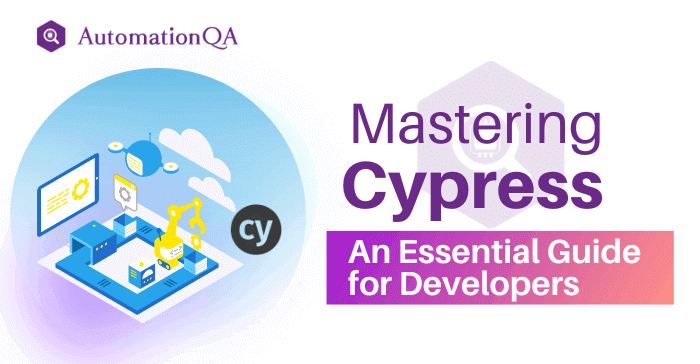
Are you seeking a dependable and effective means of automating your testing? Let us show you the ropes of Cypress and demonstrate how it can assist you in accomplishing your testing objectives. Cypress is the top web application testing framework worldwide, surpassing Selenium. For automation testing professionals, it’s the tool of choice.
If you’re new to Cypress and curious about its offers, this article is perfect for you. This blog will delve into the Cypress open source framework, its impressive features and capabilities, and its usage benefits. Additionally, we’ll provide you with a step-by-step Cypress testing tutorial.
“Leave no bug unturned – Get started with Cypress and automate your testing at scale.”
Cypress Framework and Architecture
Cypress is a JavaScript-based web app testing framework built using Node.JS programming language. Unlike any other testing framework, its unique architectural framework offers complete control over the browser. It can run in web browsers, allowing developers to write test cases that simulate real user actions.
Cypress Test Runner and Automation API are two primary components of Cypress open-source architecture. The Test Runner provides a unique user interface for running and managing tests. The Automation API allows developers to write custom API commands and scripts to control browser accessibility.
Salient Features and Capabilities of Cypress
Among the wide range of features and capabilities, here are the best functionalities of Cypress that make it the best of all automation testing tools:
- Time travel (view old test cases to debug and troubleshoot the app code quickly)
- Automatic waiting (wait for elements to load and become interactive to do web testing)
- Real-time reloads (reload the browser after committing changes in the test code)
- Debugging (efficient debugging tools like video recordings and screenshots to identify issues)
- Network traffic control (Control inbound and outbound network traffic to simulate various network conditions)
- Report generation (detailed reporting with parallel test execution through the Cypress dashboard)
Key Benefits of Cypress Testing
Just like its amazing feature and abilities, Cypress offers several benefits to developers, making it an ideal choice for modern web development teams.
Easy to Set Up
Cypress package includes fully baked libraries to eliminate all significant dependencies. Instead, you can easily install Cypress!
Better Debugging
Cypress has dedicated debugging tools that can identify issues and code defects in real time, reducing the time and effort required for manual troubleshooting.
Faster Test Execution
Cypress tests run much faster than other automation frameworks, enabling developers to test their code more frequently and detect issues at an early stage of development.
Improved Test Reliability
Cypress allows developers to run testing in the web browser, automatically reducing wait time/load time. This makes testing more reliable and reduces the chances of false positives.
Simplified Test Writing
Cypress provides a simple and intuitive interface for writing tests. Developers can create and manage tests easily with this web testing framework.
Steps To Install Cypress Test Runner
For beginners, here is an easy Cypress Test Runner installation guide:
- Cypress has a single module containing bundles required to write test cases.
- Download and install the Node.JS framework from the official website.
- Create a new project directory to initialize the npm init command.
- Install the latest version of the Cypress module using the npm install Cypress command in your project directory.
- Confirm if all Cypress testing packages are installed successfully or not.
- Launch Cypress Test Runner by running the command npx Cypress open and start writing your tests
Getting Familiarized With Cypress Dashboard Service
Cypress Dashboard’s cloud-based service provides additional features and capabilities for Cypress automation testing, including:
- Test results storage (keeps test results in the cloud for easy sharing and accessibility)
- Collaborative debugging (allows inter-team and intra-team collaboration on debugging issues)
- Continuous integration support (built-in support for CI systems like Jenkins)
Running Cypress Tests on Cypress Cloud Grid
Cypress getting started with test case writing on Cloud Grid is very easy! Here is a step-by-step guide for you:
- Sign up for Cypress Dashboard Service for free Cypress dashboard pricing on the Cypress website.
- Access Cypress Cloud Grid to run tests on the web browsers.
- Install the Cypress package module using the npm install Cypress command in your project directory.
- Configure the necessary settings to use the Dashboard Service.
- Add your dashboard record key to your Cypress.json file.
- Run tests on the Cypress Cloud Grid with the –record flag.
- Record your Cypress testing examples and upload the results to the Dashboard Service.
Utilize Cypress To Automate At Scale
Did you get a brief idea about what is Cypress? Cypress is a robust open-source testing framework offering a unique web app testing approach. You have read its features, capabilities, and usage benefits. Now, it’s time to implement your knowledge to perform faster test execution with Cypress!
Improve test reliability and simplify the entire test writing by following the above-outlined steps to install and use Cypress testing services. Check out Cypress Dashboard Service and Cypress Cloud to automate your testing at scale.
